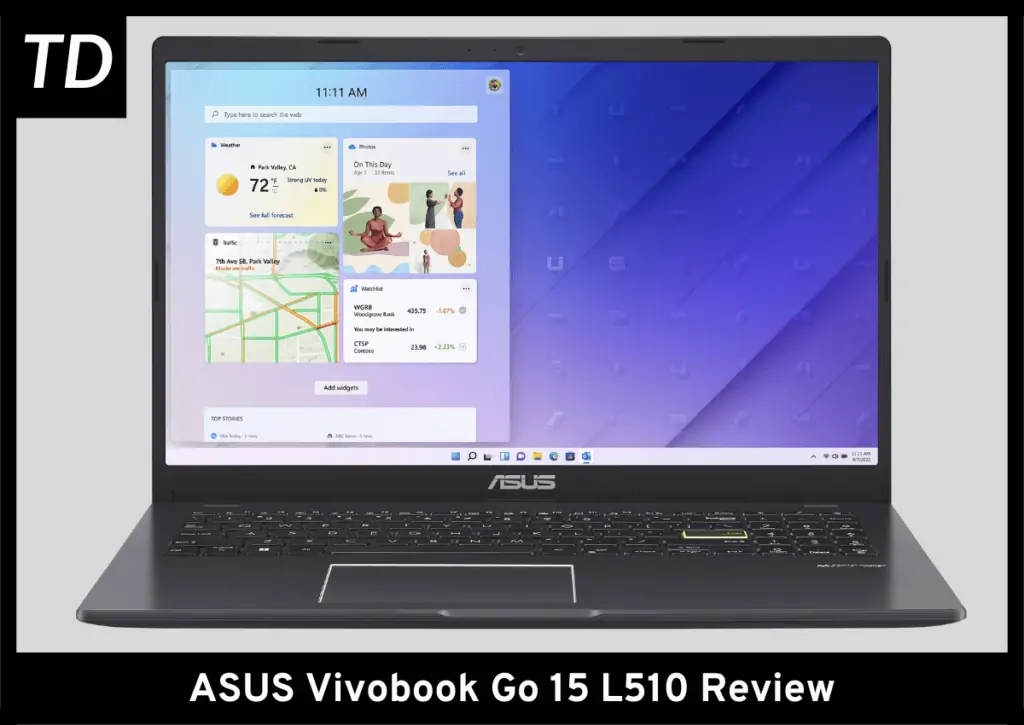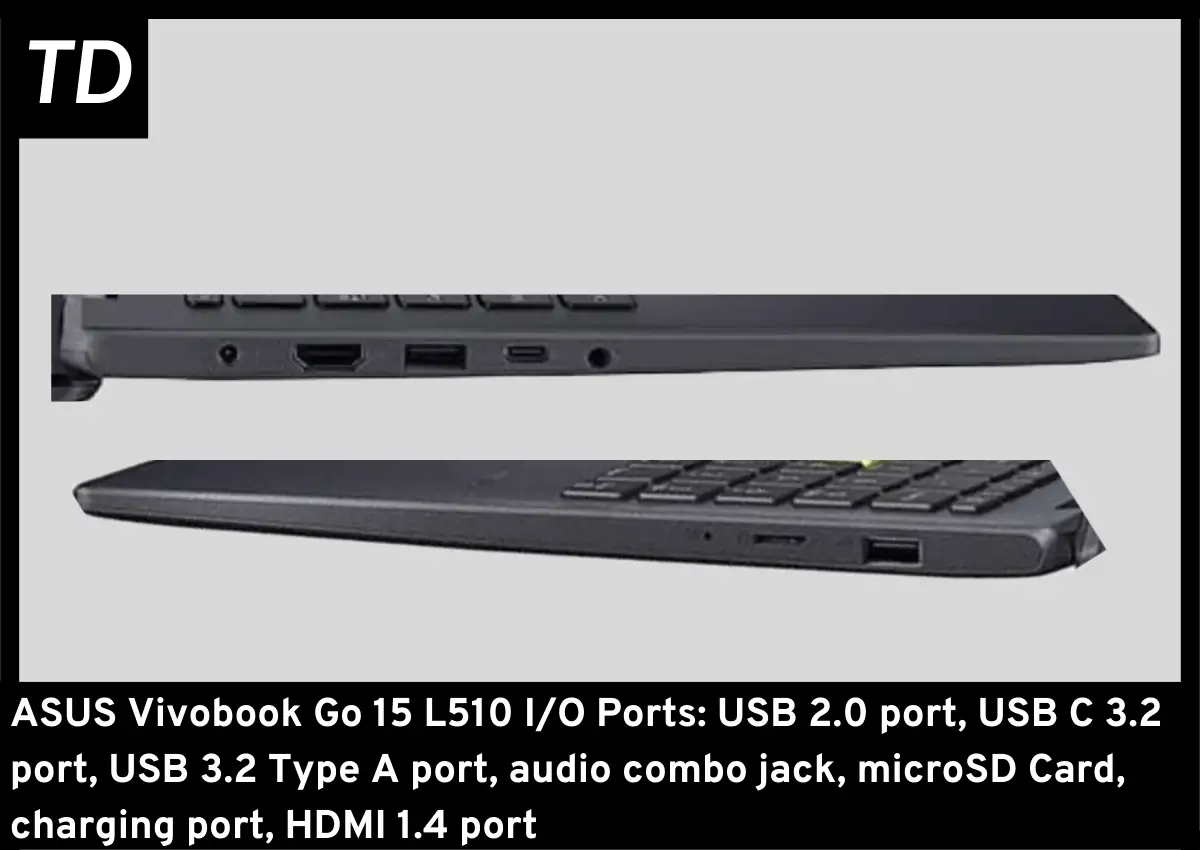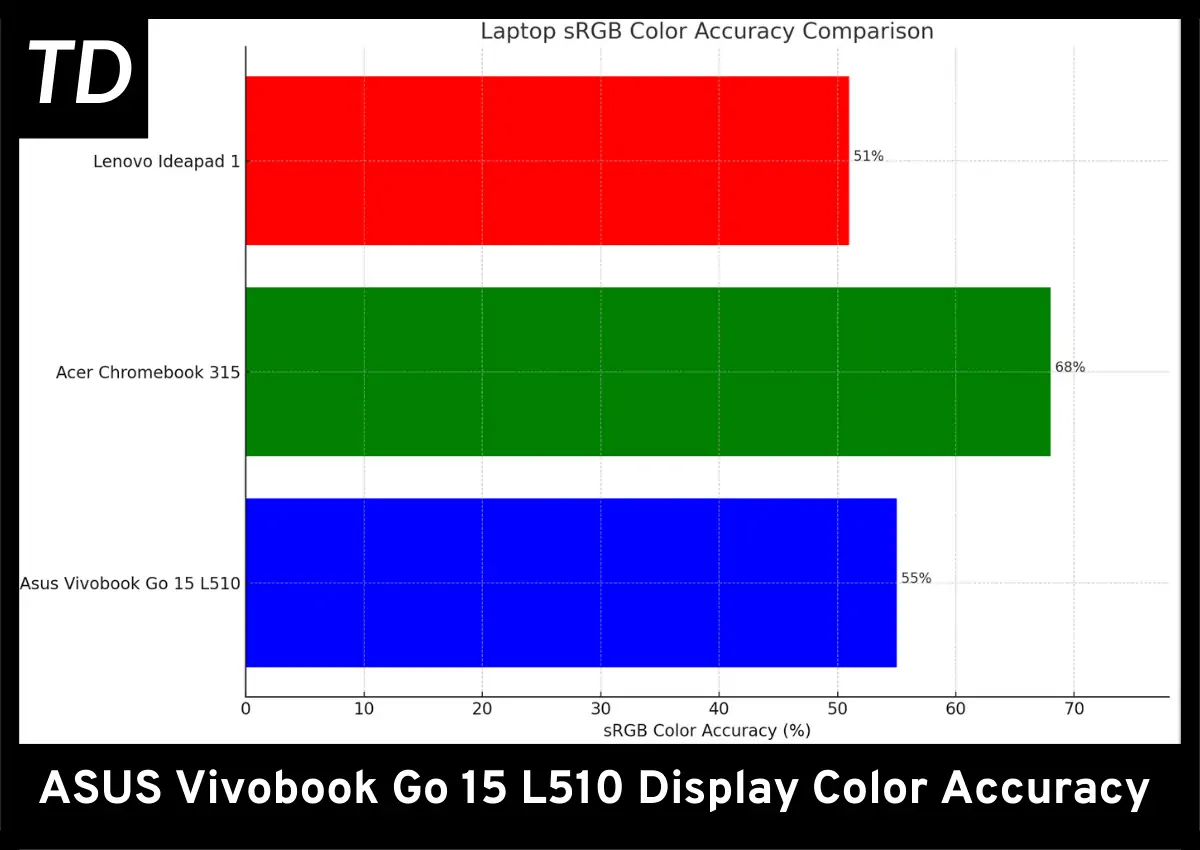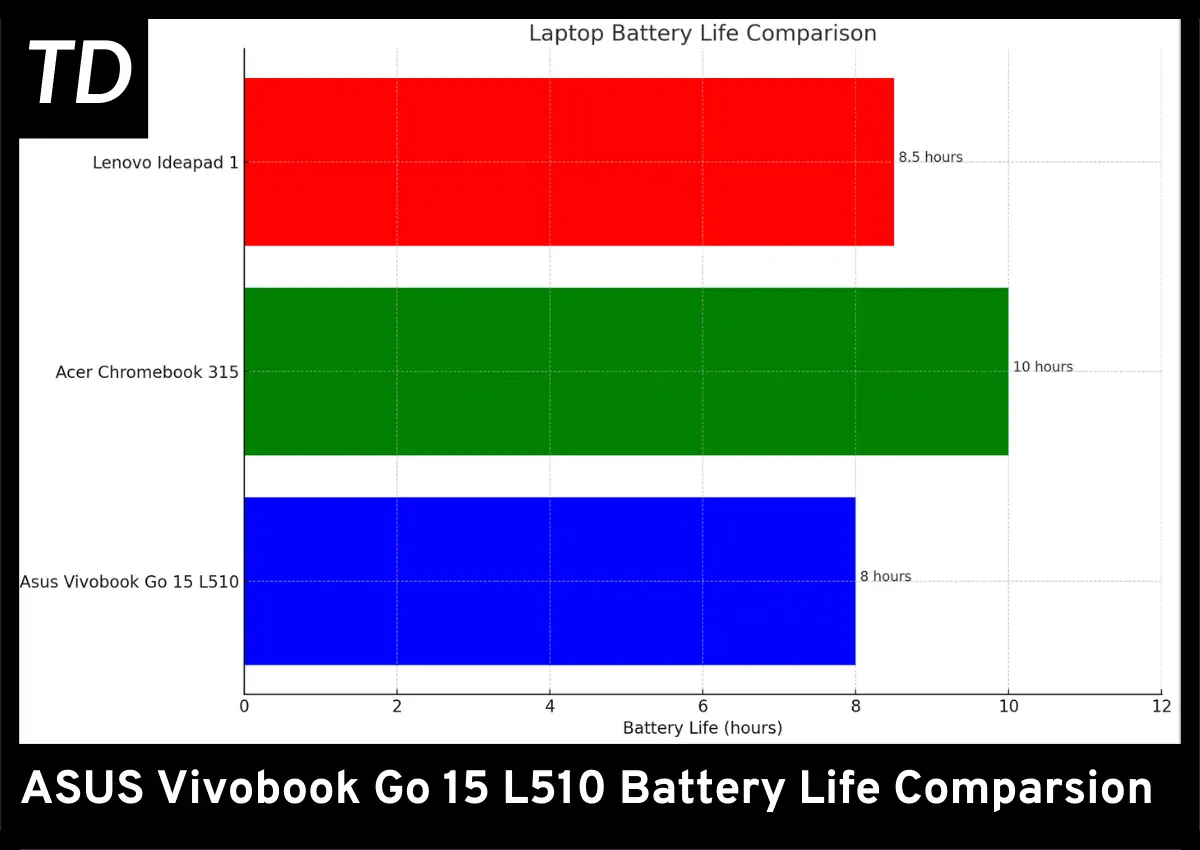The market is filled with cheap budget laptops, and Asus decided to enter this market with the Vivobook Go 15 L510. And compared to what the competition have to offer under $200, the Vivobook Go 15 L510 struggles to differentiate itself compared to the competition.
Build & Design
Weighing in at a comfortable 1.57 kg (3.46 lbs) and measuring 14.18″ x 9.31″ x 0.71″, the Asus Vivobook Go 15 L510 can be considered a bit hefty considering the fact that laptops that cost more while packing in more hardware weigh much more than this. But considering it’s 15 inch size, I guess it makes sense.
The design on the Vivobook L510 is as basic as you might expect. It has a plastic body colored in metallic blue, with the lid having a simple Asus logo in the center. It’s not that I was expecting something extraordinary here, but there’s nothing that will amaze you either.
The build quality isn’t top-notch, which is a common theme in these cheap laptops, but it’s sturdy enough for everyday use. The design is minimalistic, appealing to those who prefer a more understated look. Including me.
I/O and Ports
The ASUS Vivobook Go 15 L510 comes equipped with a decent array of I/O ports, including 1x USB 2.0 Type-A, 1x USB 3.2 Gen 1 Type-A, 1x USB 3.2 Gen 1 Type-C, 1x HDMI 1.4, a headphone/headset jack, a DC-in, and a MicroSD card reader.
The I/O ports are a somewhat appreciable part of the Vivobook go L510, and it’s on par with the competition such as the HP 15 inch or the Ideapad 1 by Lenovo. Considering on the high end you only get few USB C ports. And if the manufacturer is feeling a bit generous they might throw in an a USB Type A port.
And if you were to go the Chromebook route and pick up something like the Acer Chromebook 315, you would be deprived of something as basic as an HDMI port, and would have to adapt to the dongle life.
Keyboard & Touchpad
Keyboard
Typing on the ASUS Vivobook Go 15 L510 is a decent experience. The basic chiclet keyboard, while not offering much in terms of travel and feedback, gets the job done. The keys are neither too mushy nor too clicky, striking a balance that’s comfortable for prolonged typing sessions.
The inclusion of a numpad is a boon for users who frequently work with numbers. However, the absence of a backlit feature might be a downside for those who work in dimly lit environments.
The keyboard is also on par with the competition with HP 15 inch taking a minor lead for me. As I prefer the clicky and satisfying feel that they usually have.
But, overall, the keyboard is fine. You also have the accented Enter button that seems to be consistent theme across Asus budget Vivobook lineup.
Touchpad
The touchpad of the Vivobook Go 15 L510 is of normal size and, while not the best in the market, it performs adequately. The surface texture is smooth, and the tactility of the clicks is satisfactory. It tracks well for the most part, and gestures like pinch and zoom work without much hassle. However, it’s not the most responsive when compared to higher-end models, but for everyday tasks, it’s more than sufficient.
Speakers and Webcam
Speakers
The speakers of the ASUS Vivobook Go 15 L510 are, frankly, underwhelming. They produce sound that’s heavy on mids, lacking both bass and treble.
This results in a somewhat tinny audio experience, which might not be ideal for those who enjoy listening to music or watching movies without headphones. The placement of the speakers doesn’t do much to enhance the audio experience either.
I would just suggest you to use headphones with it, and if you plan to use it on a soft surface like a bed, then the sound would get muffled, making it even worse. So getting a decent pair of headphones is what you should look into if you plan to watch youtube videos or listening to podcasts.
Don’t expect amazing sound from any laptop at this similar price point. Speakers on these budget laptops are always the least of the manufacturer’s concerns when they make a laptop.
Webcam
The 720p webcam is a bit of a letdown. It’s grainy and struggles with color reproduction, making it less than ideal for video conferencing. The image quality is passable for casual use but if you go to meetings on the regular then this is not it.
The webcam on the Vivobook Go 15 L510 should be considered as a last resort option if you are unable to use an external webcam.
Display
The 1080p, 15.6-inch display of the Vivobook Go 15 L510 is a mixed bag. On one hand, the full HD resolution is a welcome feature at this price point, making text and images reasonably sharp.
The 1080p resolution of the Vivobook Go 15 L510 really helps it set it apart from the likes of Ideapad 1 and the Acer Chromebook 315 where both of these include an awful 768p display.
Regardless, similar to the competition, the display struggles in terms of brightness and color accuracy. It covers only a basic range of the sRGB color space, making it less suitable for tasks that require precise color representation, such as photo editing.
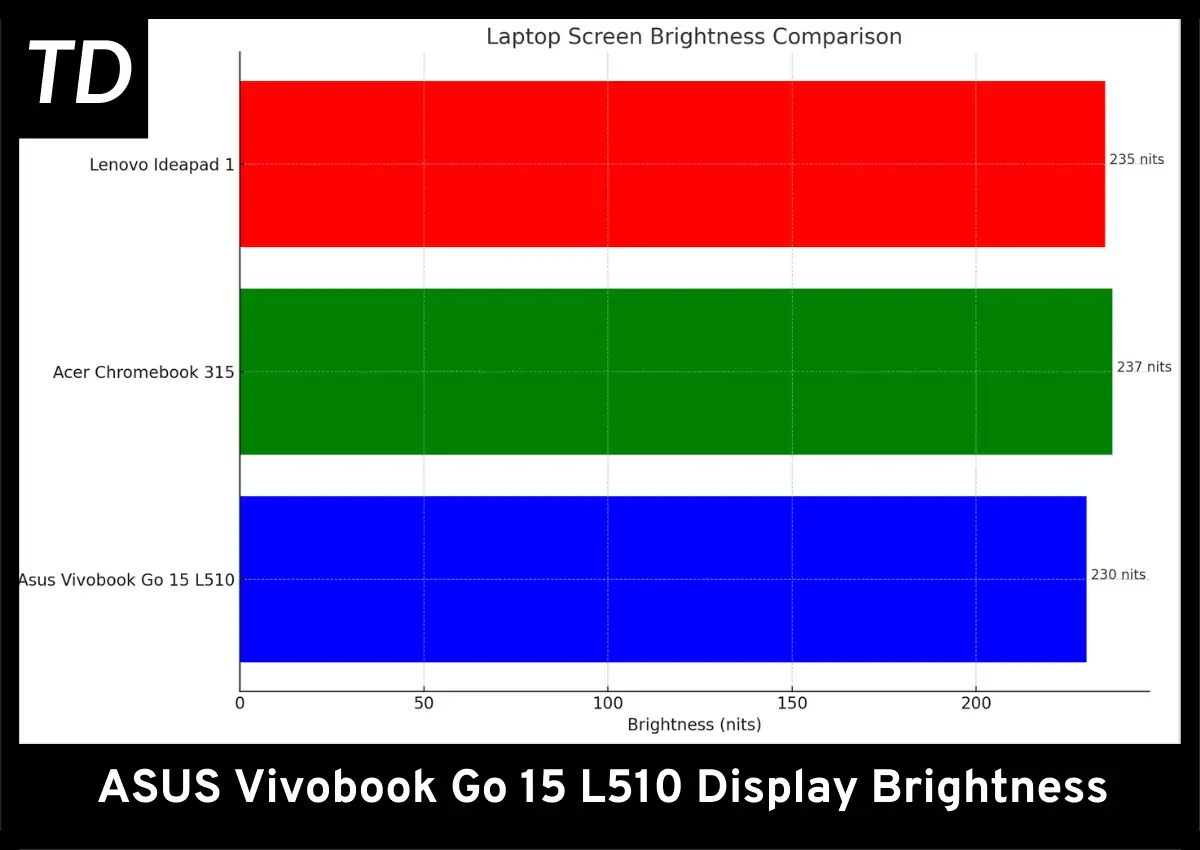
The poor brightness levels also mean that the laptop is best used indoors, as the screen can be hard to view in bright light. The 230 nits of brightness is what you will come to expect from budget laptops in the Vivobook L510 league.
The 60Hz refresh rate and the aspect ratio are standard for a budget laptop, and for basic tasks it’s sufficient.
Performance
Let’s talk about the most disappointing part of the Asus Vivobook Go 15 L510, performance. We are moving towards a future where 8GB RAM have become a minimum standard for laptops, and the Vivobook Go 15 L510 only comes with 4GB RAM. Needless to say, the entire laptops comes to its knees when you open any other app, and the poor N4020 Celeron is peaked at 100% usage most of the time.
As you might expect, Multitasking can be a challenge, and the system struggles with more than a few open tabs or applications. And the Cinebench R23 and Geekbench 5 scores are also just miserable to say the least.
The performance is notably lackluster when compared to competitors like the Acer Chromebook 315, which offers up to 8GB RAM with the same offer. And since it’s a Chromebook, it lightweight and provide comparatively much better performance then the Vivobook Go 15 L510.
And this makes it one dealbreaker that makes it hard for me to recommend, considering it struggles in basic tasks. The only way to make this laptop slightly functional is by installing Chrome OS Flex. But at that point, you are just better off buying the Acer Chjromebook 315.
Battery
The 42Wh battery of the ASUS Vivobook Go 15 L510 is one of its stronger aspects. It can last up to 8 hours on a single charge during moderate use, and can help you get yout through the day.
But here also the Chromebook 315 takes the lead again with it’s 10 hours of battery backup on moderate use.
Expansion and Upgradability
Another major limitation of the ASUS Vivobook Go 15 L510 is the lack of expandability. Both the RAM and storage are soldered, meaning there’s no option to upgrade them in the future.
Which means that if you were planning to upgrading the RAM or the storage on this miserable laptop, you can’t. And you can expect the same on laptops with the Intel Celeron N4020.
Conclusion
Despite being somewhat good when it comes to the display sharpness, I/O ports and the battery life, The awful performance and the lack of upgrade options makes the Vivobook Go 15 hard to recommend.
I would suggest you increase your budget and considering investing in something like the Lenovo Ideapad 3 or the Acer Aspire 3 which have much more capable processors and upgradable storage.

